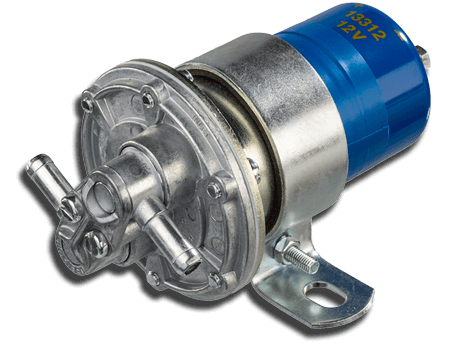A fuel pump is a frequently (but not always) essential component on a car or other internal combustion engined devices. A fuel pump draws petrol out of the tank through a pipe to the carburettor.
A fuel pump draws petrol out of the tank through a pipe to the carburettor. The pump may be mechanically worked by the engine – or it may be electric, in which case it is usually next to or even inside the fuel tank.
Fuel Pump Location
Most fuel injection system primary fuel pumps are located inside the fuel tank and have the fuel level sensor connected to the pump housing. Even though this electric motor is submerged in fuel there is no danger of fire due to the lack of oxygen inside the tank. Servicing the pump or level sender requires the removal of the pump which can be done through a service port in the car’s body or by removing the fuel tank.
How a Mechanical Pump Works
A mechanical fuel pump is driven by the camshaft, or by a special shaft driven by the crankshaft. As the shaft turns, a cam passes under a pivoted lever and forces it up at one end.
The other end of the lever, which is linked loosely to a rubber diaphragm forming the floor of a chamber in the pump, goes down and pulls the diaphragm with it.
When the lever pulls the diaphragm down, it creates suction that it draws fuel along the fuel pipe into the pump through a one-way valve.
As the revolving cam turns further, so that it no longer presses on the lever, the lever is moved back by a return spring, relaxing its pull on the diaphragm.
The loosely linked lever does not push the diaphragm up, but there is a return spring that pushes against it.
The diaphragm can move up only by expelling petrol from the chamber. The petrol cannot go back through the first one-way valve, so it goes out through another one leading to the carburettor.
The carburettor admits petrol only as it needs it, through the needle valve in its float chamber.
How an electric pump works
An electric pump has a similar diaphragm-and-valve arrangement, but instead of the camshaft, a solenoid (an electromagnetic switch) provides the pull on the diaphragm.
The solenoid attracts an iron rod that pulls the diaphragm down, drawing petrol into the chamber.
At the end of its travel, the iron rod forces apart a set of contacts, breaking the current to the electromagnet and relaxing the pull on the diaphragm.
When the diaphragm return and the spring raises the diaphragm, it also pulls the rod away from the contacts; they then close so that the solenoid pulls the rod and diaphragm gets down again.
If you’re fortunate you won’t have to replace a fuel pump, which is often located in the fuel tank.
Taking care of your fuel pump:
If properly cared for, several auto mechanics say fuel pumps should last the entire life of a car.
To extend the life of your fuel pump, never let your car’s fuel level fall below a quarter of a tank. The fuel pump should last as long as you own the car, but people tend to run the fuel tank too low, which causes them to wear out. The fuel in the tank cools the pump, but when the petrol runs down to empty, the pump could overheat. If the tank is empty and new petrol is pumped in, it could cause thermal shock to the pump.
Changing the fuel filter — located in the fuel line — will also help preserve the fuel pump. It’s job is to purify the petrol going to the injectors.
Pepo Auto Parts, is an Automobile Parts seller in Ethiopia founded in 2015. Pepo provides selection of high quality genuine spare parts especially focusing on MERCEDES and RENAULT Automobiles.

